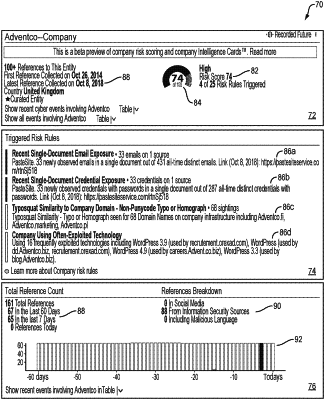| CPC G06F 21/56 (2013.01) [G06F 21/552 (2013.01); G06F 2221/034 (2013.01)] | 12 Claims |

|
1. A computer security monitoring method, including:
acquiring and storing data relating to interactions with malware controllers over a public network,
acquiring and storing a map of relationships between networks connected to the public network,
extracting risk data from the stored data relating to interactions with the malware controllers and the stored map of relationships by cross-referencing the acquired interaction data against the map of relationships,
issuing security alerts based on the extracted risk data, and
issuing reports that each include a plurality of visual elements that visually summarize the relationships and the interactions with malware controllers that lead to the issuing of security alerts, wherein the visual elements are responsive to user actuation and wherein user action of actuating of the visual elements causes the user to explore the relationships and the interactions with malware controllers that lead to the issuing of security alerts, wherein the presenting visual elements further presents the visual elements as including series of textual links that visually summarize additional information about the relationships and the interactions with malware controllers that lead to the issuing of security alerts, and wherein actuating of the textual links causes the user to explore the additional information about the relationships and the interactions with malware controllers that lead to the issuing of security alerts.
|